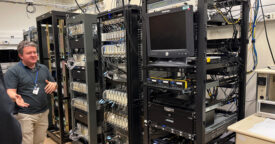On January 14, 2025, members of the Denver and Pikes Peak LMAG visited the National Institute of Standards and Technology (NIST) Laboratory in Boulder, Colorado.
Those of us old enough to be Life Members might recall a hit song released in 1969 by the band Chicago. The song asked, “Does Anybody Really Know What Time It Is?” LMAG members who took the tour now know the answer to that question is a resounding “yes.”
Although lead singer Robert Lamm was being philosophical when he sang those words, the physicists and engineers in the Time and Frequency Division at NIST view that question quite literally. According to a NIST news release, the newest generation optical atomic clocks they are working with “are expected to lose only one second every 30 billion years.”
 The group visited the Katharine Blodgett Gebbie Laboratory of NIST. The facility is named for the lab director who led the organization for more than 45 years. During her tenure, NIST won four Nobel Prizes in Physics.
The group visited the Katharine Blodgett Gebbie Laboratory of NIST. The facility is named for the lab director who led the organization for more than 45 years. During her tenure, NIST won four Nobel Prizes in Physics.
The group also toured the Photonic Synthesis Lab and the Chip-scale Atomic Devices Lab where NIST is developing next generation Photonic time measurement devices to increase Universal Time accuracy beyond today’s Cesium Atom Clock. The next stop was the Atomic Fountains Lab that is the current source of US Universal Time. The device manipulates Cesium atoms to measure their atomic decay to calculate precise time. Finally, the group toured the Time Realization and Distribution Lab.
NIST distributes Universal Time information via the internet (time.gov), WWV at 2.5, 5, 10,15, 20, and 25 MHz, and low frequency WWVB at 60KHz. They also distribute time via satellite links.



